Multigenic control of disease severity after virulent Mycobacterium tuberculosis infection in mice
- PMID: 12496157
- PMCID: PMC143141
- DOI: 10.1128/IAI.71.1.126-131.2003
Multigenic control of disease severity after virulent Mycobacterium tuberculosis infection in mice
Abstract
Following challenge with virulent Mycobacterium tuberculosis, mice of the I/St inbred strain exhibit shorter survival time, more rapid body weight loss, higher mycobacterial loads in organs, and more severe lung histopathology than mice of the A/Sn strain. We previously performed a genome-wide scan for quantitative trait loci (QTLs) that control the severity of M. tuberculosis-triggered disease in [(A/Sn x I/St) F1 x I/St] backcross-1 (BC1) mice and described several QTLs that are significantly or suggestively linked to body weight loss. In the present study we expanded our analysis by including the survival time phenotype and by genotyping 406 (A/Sn x I/St) F2 mice for the previously identified chromosomal regions of interest. The previously identified 12-cM-wide QTL on distal mouse chromosome 3 was designated tbs1 (tuberculosis severity 1); the location of the QTL on proximal chromosome 9 was narrowed to a 9-cM interval, and this QTL was designated tbs2. Allelic variants of the tbs2 locus appeared to be involved in control of both body weight loss and survival time. Also, the data strongly suggested that a QTL located in the vicinity of the H-2 complex on chromosome 17 is involved in control of tuberculosis in mice of both genders, whereas the tbs1 locus seemed to have an effect on postinfection body weight loss in female mice. Interestingly, these loci appeared to interact with each other, which suggests that there might be a basic genetic network for the control of intracellular parasites. Overall, linkage data reported here for F2 mice are in agreement with, and add to, our previous findings concerning the control of M. tuberculosis-triggered disease in the BC1 segregation.
Figures




References
-
- Artzt, K., K. Abe, H. Uehara, and D. Bennett. 1988. Intra-H-2 recombination in t haplotypes shows a hot spot and close linkage of Itw5 to H-2K. Immunogenetics 28:30-37. - PubMed
-
- Bellamy, R., C. Ruwende, T. Corrah, K. P. W. J. McAdam, M. Thursz, H. C. Whittle, and A. V. S. Hill. 1999. Tuberculosis and chronic hepatitis B virus infection in Africans and variation in vitamin D receptor gene. J. Infect. Dis. 179:721-724. - PubMed
-
- Bellamy, R., C. Ruwende, T. Corrah, K. P. W. J. McAdam, H. C. Whittle, and A. V. S. Hill. 1998. Variations in the NRAMP1 gene and susceptibility to tuberculosis in West Africans. N. Engl. J. Med. 338:640-644. - PubMed
Publication types
MeSH terms
LinkOut - more resources
Full Text Sources
Molecular Biology Databases
Miscellaneous

